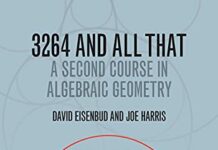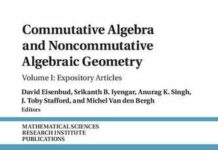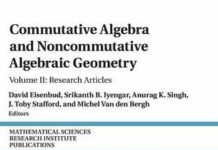
Ebook Info
- Published: 2000
- Number of pages: 304 pages
- Format: PDF
- File Size: 1.72 MB
- Authors: David Eisenbud
Description
Grothendieck’s beautiful theory of schemes permeates modern algebraic geometry and underlies its applications to number theory, physics, and applied mathematics. This simple account of that theory emphasizes and explains the universal geometric concepts behind the definitions. In the book, concepts are illustrated with fundamental examples, and explicit calculations show how the constructions of scheme theory are carried out in practice.
User’s Reviews
Editorial Reviews: Review “A great subject and expert authors!”Nieuw Archief voor Wiskunde,June 2001″Both Eisenbud and Harris are experienced and compelling educators of modern mathematics. This book is strongly recommended to anyone who would like to know what schemes are all about.”Newsletter of the New Zealand Mathematical Society, No. 82, August 2001
Reviews from Amazon users which were colected at the time this book was published on the website:
⭐This book is clear, well written, and has a nice balance of generalities and examples. If you know the basics of rings and modules, this book will show you what schemes are and why they are useful for several different problems: for example, number theory, or studying singularities. I find it a helpful companion to Hartshorne’s ALGEBRAIC GEOMETRY. But this book does not get to cohomology, and so cannot actually get to the working methods in the subject. For that, you need Hartshorne.
⭐Great introduction to Schemes, provides better intuition than Hartshorne. However the book does lack some, like a discussion of cohomology.
⭐Great book.
⭐perfect!
⭐good
⭐The theory of schemes is usually thought to be highly abstract and esoteric, and one that makes the study of algebraic geometry even more difficult. The authors definitely dispel this notion in this book, which could have been called “A Concrete Introduction to Schemes”, because of the clarity with which the concepts are introduced and explained. After studying this book, one will understand and appreciate the power of schemes in algebraic geometry. The authors do an even better job than they did in their earlier and short work “Schemes: The Language of Modern Algebraic Geometry”, which is now out of print. In chapter 1, the main definitions are given and the basic concepts behind schemes outlined. That schemes are more complicated than varieties is readily apparent even in this beginning chapter, where they are thought of as corresponding to the spectrum of a commutative ring with identity. Very elementary exercises are given to help the reader gain confidence in the constructions involved. They authors do have to discuss some sheaf theory, but they show its relevance nicely in this chapter. They also discuss the notion of a fibered product as a generalization of the idea of a preimage of a set under the application of a function and relate it to the construction of the functor of points. The role of the functor of points as reducing schemes to a kind of set theory is brought out beautifully here. The next chapter gives many examples of schemes, with the first examples being reduced schemes over algebraically closed fields, these being essentially the ordinary varieties of classical algebraic geometry. The authors then give examples of schemes, the local schemes, which are more general than varieties. When departing from the assumption of a field that is not finitely generated, extra points will have to be added to classical varieties. The fact that only one closed point appears is compared to the case of complex manifolds, via the concept of a germ. This is a very helpful comparison, and one that further solidifies the understanding of a scheme in the mind of the reader. The authors give the reader a short peek at the etale topology in one of the examples. Examples are then given where the field is not algebraically closed, generalizing classical number theory, and non-reduced schemes, where nilpotents are present. The chapter ends with examples of arithmetic schemes where the spectra of rings are finitely generated over the integers. Projective schemes are the subject of Chapter 3, and are defined in terms of graded algebras and invariants of projective schemes embedded in projective space are discussed. The Grasmannian scheme is discussed in detail as an example of a projective scheme. Interestingly, Bezout’s theorem, very familiar from elementary algebraic geometry, is generalized here to projective schemes. Constructions from classical algebraic geometry are generalized to schemes in Chapter 4. The first one discussed is the notion of a flex, which deals (classically) with the locus of tangent lines to a variety. The flexes are defined in terms of the Hessian of the variety, the latter being generalized by the authors to define a scheme of flexes. The notion of blowing up is also generalized to the scheme setting, with the authors motivating the discussion by blowing up the plane. The discussion of blow-ups along non-reduced subschemes of a scheme and blow-ups of arithmetic schemes is fascinating and the presentation is crystal clear. Fano varieties are also generalized to Fano schemes in the chapter. Most of the information about these schemes are contained in the exercises, and some of these need to be worked out for a thorough understanding. The next chapter is more categorical in nature, and deals with generalizations of the classical Sylvester construction of resultants and discriminants to the scheme setting. In the last chapter the authors return to the functor of points, and motivate the discussion by asking for a parametrization of families of schemes. The authors show, interestingly, that using the functor of points one can more easily compute geometric information about a scheme than using its equations. They illustrate this for the Zariski tangent space. Then after an overview of Hilbert schemes they close the book by introducing the reader to moduli spaces and a hint of algebraic stacks. No end in sight for this beautiful subject……….
⭐If you’re interested in learning the basics of Algebraic Geometry and Hartshorne seems too daunting, try this book instead! The authors take their time developing the material and supplement it with exercises and examples, so the student gets an intuition and a feeling for Algebraic Geometry.Definitely a good addition to a mathematician’s library.
⭐This book is a strategic step in my campaign to be able to read EGA. Namely, I bought “The Geometry of Schemes” in order to get a better intuition for schemes (which, sadly, Hartshorne failed to provide). So far so good. There are pictures and the Eisenbud clarity I so like. I still don’t get schemes, but since I haven’t really read too much of the text that is to be expected.
⭐Il libro è stato pienamente rispondente alla richiesta, in condizioni perfette così come indicato nella descrizione. sono rimasta assolutamente soddisfatta.
⭐
⭐A great book by great authors. Always near my desk!The edition is good. Not wonderful, but it is not too expensive.
Keywords
Free Download The Geometry of Schemes (Graduate Texts in Mathematics, 197) in PDF format
The Geometry of Schemes (Graduate Texts in Mathematics, 197) PDF Free Download
Download The Geometry of Schemes (Graduate Texts in Mathematics, 197) 2000 PDF Free
The Geometry of Schemes (Graduate Texts in Mathematics, 197) 2000 PDF Free Download
Download The Geometry of Schemes (Graduate Texts in Mathematics, 197) PDF
Free Download Ebook The Geometry of Schemes (Graduate Texts in Mathematics, 197)




